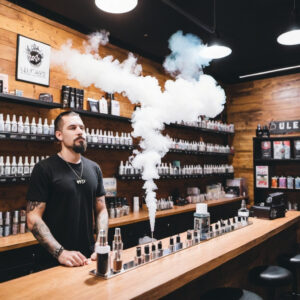The Vital Role of Vape Shops in Helping Smokers Transition to a Potentially Less Harmful Alternative
Introduction
In recent years, the emergence of vaping as an alternative to traditional smoking has sparked significant debate and interest. Vape shops, which sell e-cigarettes and related products, have become central to this transition, providing smokers with access to potentially less harmful alternatives. This article explores the critical role that vape shops play in aiding smokers to switch, the health implications, regulatory landscape, and the future of vaping as a public health strategy.
The Evolution of Vaping
Vaping involves using electronic devices, commonly known as vapes or e-cigarettes, to inhale vapor produced from a liquid, often containing nicotine. Unlike traditional cigarettes, which burn tobacco, vapes heat a liquid solution to create vapor. This method of nicotine delivery is considered by many to be a less harmful alternative to smoking, which involves the inhalation of tar and numerous carcinogens.
Historical Context
The concept of vaping dates back to the early 2000s when the first commercially successful e-cigarette was introduced. Since then, the industry has seen rapid growth and technological advancements, leading to a wide variety of devices and e-liquids available on the market today.
Health Implications of Vaping vs. Smoking
Reduced Exposure to Harmful Chemicals
One of the primary arguments in favor of vaping is the significant reduction in exposure to harmful chemicals compared to smoking. Traditional cigarettes contain thousands of chemicals, many of which are toxic and carcinogenic. In contrast, e-liquids typically contain far fewer ingredients, and while not completely risk-free, they generally present fewer health risks.
Nicotine Addiction
While vaping is considered less harmful than smoking, it is not without its risks. Nicotine, the addictive substance found in both cigarettes and most e-liquids, can still lead to dependence and various health issues. However, the ability to control nicotine levels in e-liquids allows users to gradually reduce their intake, potentially aiding in the cessation of nicotine use altogether.
The Role of Vape Shops
Providing Access to Alternatives
Vape shops are the primary retail outlets for e-cigarettes and related products. They offer a wide range of devices, e-liquids, and accessories, making it easier for smokers to find alternatives that suit their preferences. The availability of various flavors and nicotine strengths allows for a customized experience, which can be crucial in making the switch from smoking to vaping.
Education and Support
One of the most significant roles that vape shops play is in educating customers about vaping. Knowledgeable staff can provide information on the proper use of devices, the differences between products, and the potential health benefits of switching from smoking to vaping. This educational aspect is critical in helping smokers make informed decisions and use vaping products safely and effectively.
Community and Peer Support
Vape shops often serve as community hubs where customers can share experiences and support each other in their journey to quit smoking. This sense of community can be incredibly beneficial, providing moral support and practical advice from others who have successfully transitioned to vaping.
Regulatory Landscape
Federal and Local Regulations
Vape shops operate under a complex regulatory framework that varies by country and region. In the United States, for instance, the Food and Drug Administration (FDA) regulates the sale and marketing of vaping products. These regulations are designed to ensure product safety, prevent underage sales, and control marketing practices.
Age Restrictions
One of the most critical regulations affecting vape shops is the enforcement of age restrictions. Most countries have set a minimum age for purchasing vaping products to prevent minors from accessing them. In the U.S., the legal age is 21, while in many other countries, it is 18. Vape shops must implement strict age verification procedures to comply with these laws.
Marketing and Advertising Restrictions
To prevent the promotion of vaping products to minors, many regions have imposed strict marketing and advertising restrictions. These can include bans on certain types of advertising, restrictions on flavor names, and requirements for health warnings on packaging. Vape shops must navigate these regulations to ensure their marketing practices are compliant.
Challenges Faced by Vape Shops
Navigating Regulatory Compliance
Vape shops face the ongoing challenge of staying compliant with ever-evolving regulations. This requires a thorough understanding of federal, state, and local laws, as well as the ability to adapt quickly to changes. Non-compliance can result in severe penalties, including fines and the revocation of business licenses.
Public Perception and Misinformation
The vaping industry often contends with negative public perception and misinformation. Concerns about health risks, particularly in relation to youth vaping, have led to increased scrutiny and negative media coverage. Vape shops must work to educate the public and counteract misinformation by providing accurate information and promoting responsible vaping.
Competition and Market Saturation
As the popularity of vaping has grown, so has the number of vape shops. This increased competition can make it challenging for individual shops to stand out and attract customers. Offering high-quality products, exceptional customer service, and knowledgeable staff are essential strategies for success in a crowded market.
The Future of Vaping as a Public Health Strategy
Potential for Harm Reduction
The concept of harm reduction is central to the argument for vaping as a public health strategy. By providing smokers with a less harmful alternative, vaping has the potential to reduce the overall health burden associated with tobacco use. Public health organizations in several countries have recognized this potential and are incorporating vaping into their tobacco control strategies.
Ongoing Research and Evidence
Continued research is essential to fully understand the long-term health effects of vaping. While current evidence suggests that vaping is less harmful than smoking, ongoing studies are needed to monitor potential risks and benefits. This research will help inform regulatory decisions and public health recommendations.
Global Trends and Policies
The global approach to vaping varies significantly, with some countries embracing it as a harm reduction tool and others imposing strict bans and restrictions. As more evidence emerges, it is likely that global policies will continue to evolve. International organizations, such as the World Health Organization (WHO), play a crucial role in shaping these policies and promoting best practices.
Promoting Responsible Vaping
Importance of Responsible Retail Practices
Vape shops must prioritize responsible retail practices to maintain credibility and protect public health. This includes strict age verification, accurate product information, and compliance with all regulations. By doing so, they can help ensure that vaping remains a viable alternative for smokers seeking to quit.
Consumer Education
Educating consumers about the risks and benefits of vaping is crucial. Vape shops should provide clear information on the proper use of devices, potential health effects, and the importance of not using vaping products if they are not already smokers. This education can help prevent unintended consequences, such as non-smokers taking up vaping.
Conclusion
Vape shops play an indispensable role in helping smokers transition to a potentially less harmful alternative. By providing access to a wide range of vaping products, offering education and support, and ensuring compliance with regulations, these shops contribute significantly to public health efforts aimed at reducing the harm caused by smoking.
As the vaping industry continues to evolve, it is crucial for vape shops to stay informed about regulatory changes, engage in responsible retail practices, and actively participate in public health discussions. By doing so, they can help shape a future where vaping serves as a valuable tool in the fight against tobacco-related harm, ultimately improving the health and well-being of millions of individuals worldwide.











